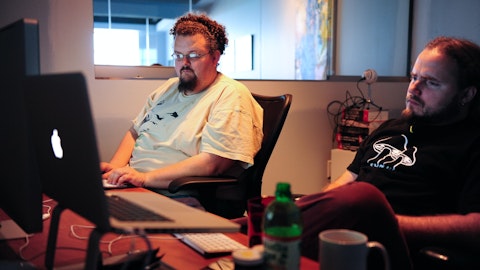Roger Krone: Yeah.
Chris Cage: Thanks, Ken.
Operator: Our next question is from the line of Cai von Rumohr with Cowen & Company. Please proceed with your questions.
Cai von Rumohr: Yes. Thanks so much. So I think early on, you talked about 6% headcount growth, and I would have to assume wages go up about 3% which would say payroll is up in the area of 9%, and your revenues are up 2% to 5%. Help us square those two items?
Chris Cage: Well, Cai, I mean, keep in mind, first of all, half of our revenue is kind of Leidos content. We’ve got subcontractors. We’ve got materials, right? So that’s only a portion of the business that you’re focused on the headcount growth. And that headcount growth that Roger talked about, the 2,400 people that we brought on last year was over the course of the year, right? We were adding them kind of pro rata throughout the year. So it’s not like that’s going to all be incremental heading into ’23. But that being said, we have big plans around the additional heads that we plan on adding again this year. So the combination of factors, headcount should be up. You’re correct. There’s payroll growth on top of that, that gives you some upside, that immediately gets passed through on the cost reimbursable programs.
You don’t necessarily get uplift immediately on your fixed price programs. But that’s part of the equation, too, that would suggest, if we’re successful, we don’t have any major losses, and we continue to win our fair share, we like the momentum that we see on the growth side.
Cai von Rumohr: Thanks. And the second one is, you have very strong bid submits. And Roger, you mentioned we have a very strong FY ’23 budget. So there’s lots of money available. Can you give us some color on what you expect your book-to-bill might be in ’23 and what that would suggest for ’24?
Roger Krone: Yeah. Sure, Cai. And, of course, it’s early. And we’ve got about $34 billion of submits pending awards. And we had — I don’t know whether our submits of $23 billion last quarter was a record or not. I think it probably was. So we’ve got just a lot of things out there. And so we expect ’23 to be at or better where we were in ’22. And it’s so early — we start leaning forward and then we get hit with the protest and the program gets pushed out of €˜23 to €˜24, which we’ve certainly seen happen in the past. But we feel that ’23 is going to be strong. And the ’22 levels or better. There’s always a couple of wild cards. It says you would win. There are a couple, I would say, maybe more sort of like 1 square over that we could win that would really fuel the top end.
We didn’t really put those in our plans and our guide. What we’re trying to do is to build a balanced guide around what we see in the portfolio. And again, clearly above one for the year, again, as it has been for years and years and years, but the potential for a very strong year. And then we’ll just — we’ve got fans, which still hasn’t been awarded and we’re hopeful that FIS will be awarded soon. I’ll tell you, Cai, without going into the details, there’s a program that has been under protest that we thought would be awarded in first quarter. And the customer just asked us to extend our pricing to next year. So there’s — as enthusiastic as we are. Every once in a while, we do get disappointed and the protest process and the adjudication court of federal claims tends to damp down some of our enthusiasm.
And so in the first quarter, we’re going to be thoughtful about what we put out there. But you know the number, 35, 36 in backlog, 34 awaiting award, our strong submits. And we’ll have a very strong submit year in ’23 as well.
Cai von Rumohr: Thank you very much.
Chris Cage: Thanks, Cai.
Operator: Our next question is from the line of Jason Gursky with Citigroup. Please proceed with your question.
Jason Gursky: Hey. Good morning, everyone. Just want to follow up there with kind of a follow-up question to the line of thinking that Cai had there on the bookings. You mentioned in your prepared remarks the protracted acquisition process that’s in place. That’s something we’ve been hearing for quite some time now. I’m wondering if this is just kind of the normal environment now? And what your assumptions are for the year? Are you expecting things to get better or worse on how quickly things can get out the bid and then awarded?
Roger Krone: Yeah. I mean, I’ll talk kind of top level. Chris can add in. And this is, just what I think. So everybody has their opinion there’s a lot that’s being written is what I think I’m seeing is customers wanting to get things under contract before we end up in this argument over the debt ceiling. With looming government shutdown, who knows what comes out of those discussions. If you’ve got a customer and you’ve got appropriated funds, you’re going to really work hard to get those committed between now and June. And so we are seeing a little bit more activity, and we’re hopeful that these folks will try to move a little faster and get these things under contract. And then we probably end up with an agreement on debt ceiling with some kind of a future trade on some kind of a top level budget constraint.
I mean I don’t — I’m not smart enough to know what that will look like. Last time this happened, we got sequester. But I suspect it will be something just what I read about how McCarthy got elected as a speaker, there is some kind of a budget deal that’s going to be cut for the long term. But that could be by — and I don’t really understand how you balance the budget in 10 years. Again, that’s not my job, but I run the numbers, and it seems unbelievably difficult. But that’s going to put a damper perhaps on what the budget could be. You’re starting to talk now 25%, right? And so I suspect that if you have money and you have a program and you have a mission with requirements, you’re going to work as hard as you can to get those things committed in ’23.
And I think that speaks well. And then as you know, we get an award in ’23 that’s a ’24, ’25, ’26 revenue. So again, our future, we think, is still looks relatively bright. And then plus the diversity in our portfolio, the Civil group has been growing very strongly. The health group has been growing very strongly. So we’ve been working really hard to make Leidos somewhat resistant to the vagaries of what happens from our elected officials. I don’t know, Chris, you want to add anything?
Chris Cage: No, I think you covered it well. I mean the only thing I’d say, we wish customer contracting shops were more fully staffed. They’re not in many cases. One path that we think has been successful is more use of Fed Sim. Fed Sim runs a good acquisition process. the rules are well defined. And so we’ve had some success with our teams competing in that arena, and we see more customers going in that direction.
Jason Gursky: Okay. And then quick clarification. Can I ask one clarification. You mentioned the CapEx at 1.5% this year. And I think you mentioned part of that is being driven by Australia. I’m just curious if that has to do with the recent acquisition and kind of what’s going on down there, specifically on.





